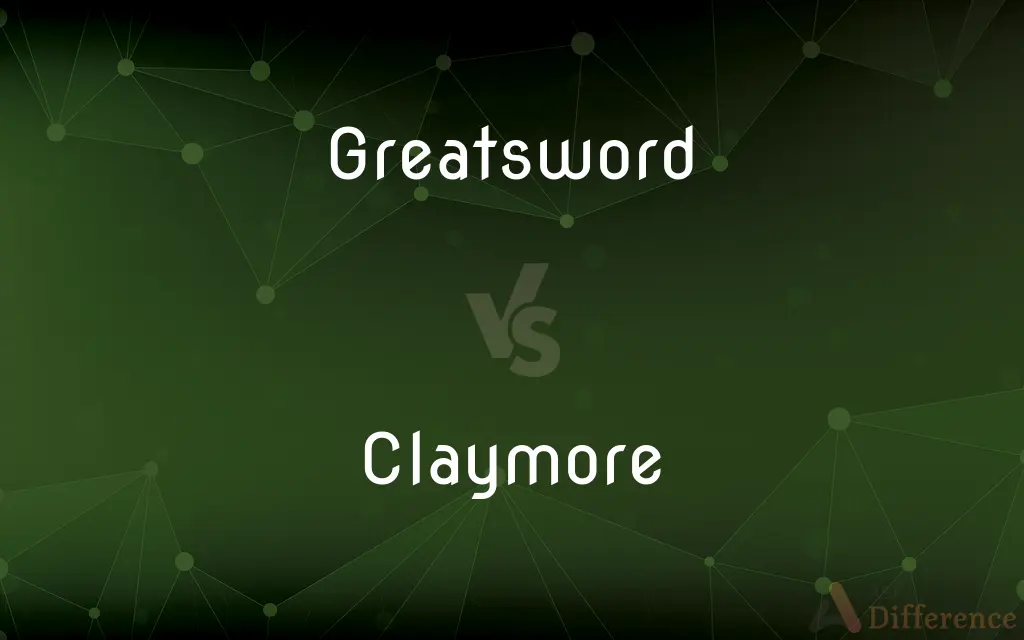Greatsword vs. Claymore — What's the Difference?
By Fiza Rafique & Urooj Arif — Updated on April 14, 2024
Greatswords are large two-handed swords with varying designs depending on culture; claymores are specifically Scottish greatswords with distinctive cross-guards.

Difference Between Greatsword and Claymore
Table of Contents
ADVERTISEMENT
Key Differences
Greatswords are characterized by their large size and long blades, used predominantly in two-handed styles. Whereas claymores, a type of greatsword, are particularly noted for their "basket-hilt" design, originating from Scotland.
Greatswords were widely used across Europe from the Renaissance onward, designed for swinging with both hands to break enemy lines. On the other hand, claymores were especially prominent in the Scottish Highlands during the 15th to 17th centuries, and were often used in clan warfare.
While greatswords may have various blade shapes and hilt designs depending on their regional origins, claymores are recognized by their forward-sloping cross guards with quatrefoils. Conversely, claymores are also sometimes distinguished by a two-handed variant with a cross-shaped hilt, which was used before the advent of the basket-hilt version.
Despite their similarities in purpose and usage, the terminology and specific design features set the claymore apart as a symbol of Scottish heritage, whereas greatswords encompass a broader category of large swords used across Europe.
Comparison Chart
Origin
Europe
Scotland
ADVERTISEMENT
Typical Usage Era
Renaissance
15th to 17th century
Handle Type
Varied, usually straight
Typically basket-hilt or straight with guards
Distinctive Features
Long blade, two-handed use
Quatrefoil cross guards, basket-hilt design
Cultural Association
Broadly European
Specifically Scottish
Compare with Definitions
Greatsword
A weapon designed for powerful blows and long reach.
In the reenactment, the greatsword was used to demonstrate medieval combat techniques.
Claymore
Appears in Scottish folklore and historical narratives.
The tale recounts the hero’s prowess with a claymore in battle.
Greatsword
Often featured in tales and historical accounts of battles.
Legends often depict heroes wielding greatswords against formidable foes.
Claymore
Recognizable by its cross-shaped guard and sometimes by a basket-hilt.
The old claymore at the highland games had intricate designs on its guard.
Greatsword
A large, two-handed sword used historically across Europe.
The knight wielded a greatsword that was almost as tall as he was.
Claymore
A traditional Scottish two-handed sword with distinctive features.
The museum's medieval section features a claymore with its iconic basket-hilt.
Greatsword
A term that encompasses various types of large swords from different cultures.
His collection includes greatswords from Germany, Italy, and Spain.
Claymore
Symbolic of Scottish heritage and martial tradition.
He wore a replica claymore as part of his traditional Scottish attire.
Greatsword
Used not just in combat but also as a symbol of power and authority.
The ceremonial greatsword was displayed prominently at the castle.
Claymore
Used primarily in the late medieval and early modern periods.
Claymores were a common sight during the Scottish clan wars.
Greatsword
Any generally straight-bladed double-edged sword large enough to require the use of two hands to wield it effectively.
Claymore
A claymore (; from Scottish Gaelic: claidheamh-mòr, "great sword") is either the Scottish variant of the late medieval two-handed sword or the Scottish variant of the basket-hilted sword. The former is characterised as having a cross hilt of forward-sloping quillons with quatrefoil terminations and was in use from the 15th to 17th centuries.
Claymore
A broadsword formerly used by Scottish Highlanders, typically double-edged.
Claymore
A type of anti-personnel mine.
Claymore
A claymore mine.
Claymore
A large, double-edged broadsword formerly used by Scottish Highlanders.
Claymore
A large two-handed sword historically used by the Scottish Highlanders.
Claymore
Antipersonnel mine
Claymore
A large two-handed sword used formerly by the Scottish Highlanders.
Claymore
A large double-edged broadsword; formerly used by Scottish Highlanders
Claymore
An anti-personnel land mine whose blast is aimed at the oncoming enemy
Common Curiosities
What is a greatsword?
A greatsword is a large, two-handed sword historically used in Europe, known for its long blade and considerable reach.
Can the term "greatsword" apply to any large sword?
While often specific to European swords, the term "greatsword" broadly applies to any large, two-handed sword across various cultures.
How were greatswords used in battle?
Greatswords were used to deliver powerful, sweeping blows, ideal for breaking through enemy lines and fighting multiple opponents.
What defines a claymore?
A claymore is a specific type of Scottish two-handed sword, often characterized by a basket-hilt or distinctive cross-guards.
What historical period is most associated with claymores?
Claymores are most associated with the 15th to 17th centuries, particularly in Scotland during times of clan warfare.
What is the main difference in the hilt design between greatswords and claymores?
Greatswords typically have varied hilt designs based on region and era, while claymores are known for their forward-sloping cross guards and sometimes a basket-hilt.
How do the weights of greatswords and claymores compare?
Both weapons are quite heavy due to their size, though the specific weight can vary depending on the exact design and materials.
Why is the claymore important in Scottish culture?
The claymore symbolizes Scottish heritage and martial prowess, representing freedom and resistance in historical contexts.
Were greatswords used by cavalry or infantry?
Greatswords were primarily used by infantry for their effectiveness in open battle and in tight formations.
Did the design of claymores influence other weapons?
Claymores influenced the design of other Scottish weapons, particularly in the development of hilts and guards.
How were greatswords wielded effectively in combat?
Due to their size, greatswords required specialized training to use effectively, emphasizing strong, controlled swings.
What materials were used to make greatswords?
Greatswords were typically made from high-quality steel, allowing for a sharp, durable blade capable of withstanding heavy use.
What role did greatswords play in medieval society?
Beyond warfare, greatswords were status symbols and were often used in ceremonial contexts.
Is the claymore still used today?
While no longer used in combat, claymores are often replicated for ceremonial purposes, historical reenactments, and cultural displays.
What makes a claymore distinct from other historical swords?
The claymore is distinct for its specific cultural ties to Scotland and its unique design features like the quatrefoil guards.
Share Your Discovery

Previous Comparison
Flavoring vs. Flavorant
Next Comparison
Bloke vs. DogAuthor Spotlight
Written by
Fiza RafiqueFiza Rafique is a skilled content writer at AskDifference.com, where she meticulously refines and enhances written pieces. Drawing from her vast editorial expertise, Fiza ensures clarity, accuracy, and precision in every article. Passionate about language, she continually seeks to elevate the quality of content for readers worldwide.
Co-written by
Urooj ArifUrooj is a skilled content writer at Ask Difference, known for her exceptional ability to simplify complex topics into engaging and informative content. With a passion for research and a flair for clear, concise writing, she consistently delivers articles that resonate with our diverse audience.















































